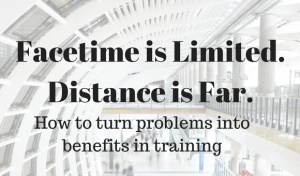[Written three years before the pandemic, this post is more relevant than ever now that most training is online.]
A challenge conflict styles trainers often face is limited time in workshops or little face-to-face access to people needing training. What then?
Here are options that can still bring good results, sometimes even better than a relaxed face-to-face workshop:
-
- Use the online version. The online version of the Style Matters inventory is optimized for remote users and has an onsite tutorial that supports self-study.
- Have them start at home. Have people take the inventory at home before they arrive at a training event. Both online and print versions of Style Matters are self-explanatory, so you can instruct your users to come to the workshop with the inventory already taken and a score report in hand. Bingo, you just saved at least 15 minutes of precious workshop time! In your workshop, start with the Intro to Conflict Style slideshow (see Free Resources in top menu on the front page of www.RiverhouseEpress.com) and continue with input on topics covered in the Trainers Guide.
- Maybe you’re working remotely with people and can’t even gather them into a workshop. Have them take the online version and review the score report on their own. Then schedule a Zoom call and discuss results, using one of the exercises described on the webpage, Ideas for Discussing Conflict Styles with Others.
- Do a series, not a one-off event. In all circumstances, you will have the greatest effect on relationships and the culture of an organization or group if you interact with participants repeatedly across time rather than in a one-off event. An online series will probably have more impact than a single face-to-fact event.
- Assign independent work. Can’t even do a web conference? You could have an individual, a team, or a whole group take the inventory and work through the inventory on their own as individuals. Then assign them to have a series of conversations based on assignments/topics you create for them drawing on the above resources. If you want to be really thorough, you could ask them to send you a written summary of key insights they learned from the experience. In that case, make it a conversation by replying to their summary.
- Journaling. With any of the above, you could have people do journal entries, just for themselves, or to share with you as trainer. Ideas for topics:
- Use the online version. The online version of the Style Matters inventory is optimized for remote users and has an onsite tutorial that supports self-study.
– “Key Insights about my conflict styles that I learned from taking Style Matters”
– “Three things I want to try to do differently with others in my group (and why) as a result of learnings from Style Matters”
– “Reflections on a week/month of effort to apply insights from Style Matters in relationships to others”
– “My strengths and weaknesses in conflict styles – reflections following taking the Style Matters inventory”.
– “Two successes and two challenges I faced this week in applying insights from the Style Matters inventory.”
– “A personal response to Principles of Wise Response to Conflict
In all cases where you are working with reports or reflections sent to you, if your purpose is to facilitate learning, make at least some reply to journals, even if only a few sentences. If you fail to do this, the writers are more likely to experience your presence as that of an authority figure to whom they are reporting rather than as a coach. The coaching role, of course, is generally more likely to facilitate reflection and learning role than an authority figure role.
A percentage of people view a conflict style inventory as a test. When taking a test, the concern is to pass, be certified, demonstrate competency, etc. Then forget about it!
But we’re not interested in getting people to prove their competence. We want to help them get started on a lifelong journey of careful thought about how to best manage differences with others. So we encourage people to “take the numbers with a grain of salt”, to view them as an opener in a conversation with self and others about how to grow through conflict.
We all know, of course, that a one-off, face-to-face workshop is immediate and direct in ways that remote learning is not. But that experience often ends when the workshop ends.
Remote work, strangely enough, has some advantages when it comes to continuity. It’s often easier to do followup by email, phone, or video than to set up a face-to-face meeting. If you’re diligent about this, you can facilitate a reflection and learning process that surpasses what people would get in a typical once-and-done event.


